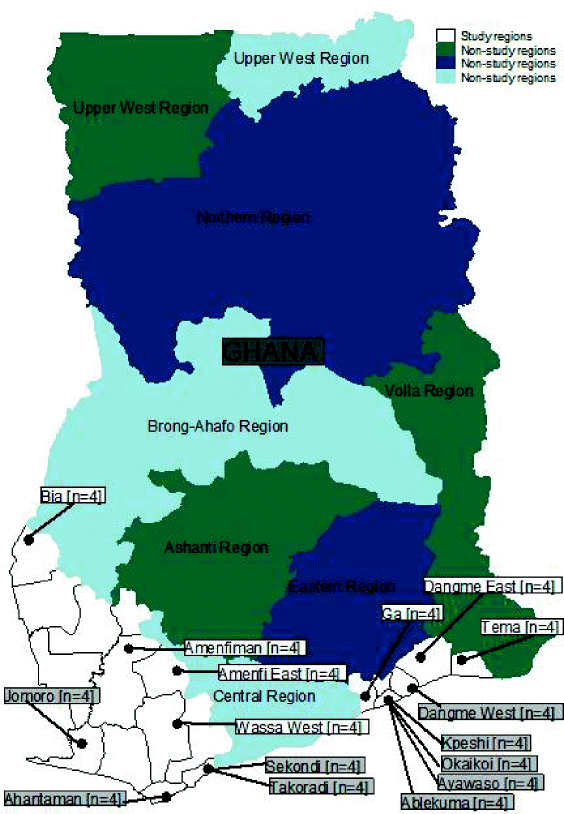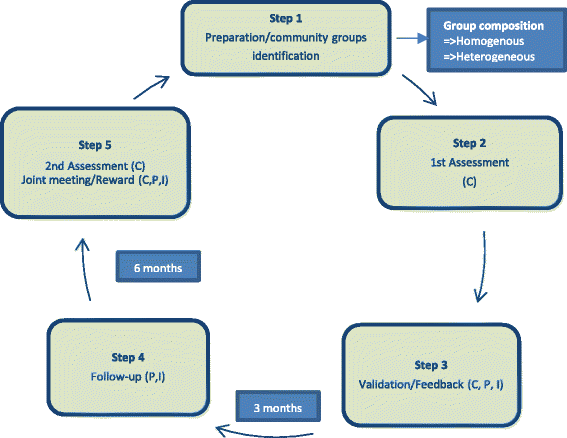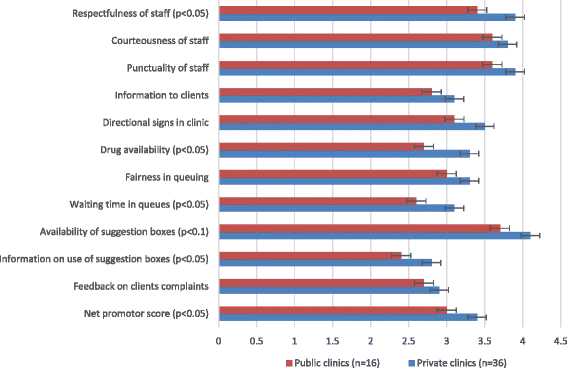Design and implementation of community engagement interventions towards healthcare quality improvement in Ghana: a methodological approach
- PMID: 27785769
- PMCID: PMC5081980
- DOI: 10.1186/s13561-016-0128-0
Design and implementation of community engagement interventions towards healthcare quality improvement in Ghana: a methodological approach
Abstract
Background: Nearly four decades after the Alma-Ata declaration of 1978 on the need for active client/community participation in healthcare, not much has been achieved in this regard particularly in resource constrained countries like Ghana, where over 70 % of communities in rural areas access basic healthcare from primary health facilities. Systematic Community Engagement (SCE) in healthcare quality assessment remains a grey area in many health systems in Africa, albeit the increasing importance in promoting universal access to quality basic healthcare services.
Purpose/objective: Design and implement SCE interventions that involve existing community groups engaged in healthcare quality assessment in 32 intervention primary health facilities.
Methods: The SCE interventions form part of a four year randomized controlled trial (RCT) in the Greater Accra and Western regions of Ghana. Community groups (n = 52) were purposively recruited and engaged to assess non-technical components of healthcare quality, recommend quality improvement plans and reward best performing facilities. The interventions comprised of five cyclical implementation steps executed for nearly a year. Wilcoxon sign rank test was used to ascertain differences in group perceptions of service quality during the first and second assessments, and ordered logistic regression analysis performed to determine factors associated with groups' perception of healthcare quality.
Results: Healthcare quality was perceived to be lowest in non-technical areas such as: information provision to clients, directional signs in clinics, drug availability, fairness in queuing, waiting times, and information provision on use of suggestion boxes and feedback on clients' complaints. Overall, services in private health facilities were perceived to be better than public facilities (p < 0.05). Community groups dominated by artisans and elderly members (60+ years) had better perspectives on healthcare quality than youthful groups (Coef. =1.78; 95 % CI = [-0.16 3.72]) and other categories of community groups (Coef. = 0.98; 95 % CI = [-0.10 2.06]).
Conclusions: Non-technical components of healthcare quality remain critical to clients and communities served by primary healthcare providers. The SCE concept is a potential innovative and complementary quality improvement strategy that could help enhance client experiences, trust and confidence in healthcare providers. SCE interventions are more cost effective, community-focused and could easily be scaled-up and sustained by local health authorities.
Keywords: Community engagement; Ghana; Healthcare quality; Primary health facilities.
Figures




References
-
- Declaration of Alma-Ata, International Conference on Primary Health Care, Alma-Ata, USSR. Jointly sponsored by the World Health Organization (WHO) and United Nations Children's Fund (UNICEF), 6–12 September; 1978.
-
- Morgan MN, Lifshay J. Community Engagement in Public Health, California Endowment under the sponsorship of Contra Costa Health Services (CCHS) 2006.
-
- Coulter A. Engaging communities for health improvement: a scoping study for the Health Foundation. Produced as a scoping paper by the Health Foundation. United Kingdom: Health Foundation London; 2010.
-
- Coleman JS. Social capital in the creation of human capital source. Am J Sociol. 1988;94(Suppl):S95–S120. doi: 10.1086/228943. - DOI
-
- Taplin D, Clark H, Collins E, Colby D. Technical papers: a series of papers to support development of theories of change based on practice in the field. New York: Acknowledge and The Rockefeller Foundation; 2013.
LinkOut - more resources
Full Text Sources
Other Literature Sources
Research Materials

